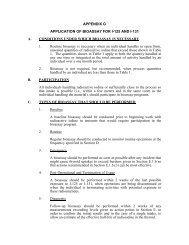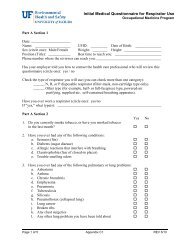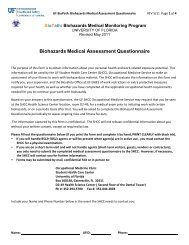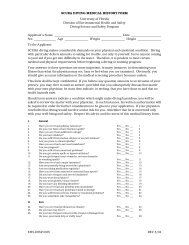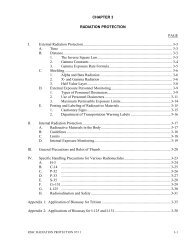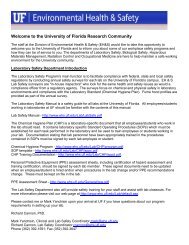CHAPTER 2 FUNDAMENTAL RADIATION CONCEPTS PAGE I ...
CHAPTER 2 FUNDAMENTAL RADIATION CONCEPTS PAGE I ...
CHAPTER 2 FUNDAMENTAL RADIATION CONCEPTS PAGE I ...
- No tags were found...
You also want an ePaper? Increase the reach of your titles
YUMPU automatically turns print PDFs into web optimized ePapers that Google loves.
III.RADIOACTIVE DECAY MODESA. Beta Minus DecayWhen the neutron to proton ratio is too high, a neutron "transforms" into a protonand electron, with the electron being ejected from the nucleus. The ejectedelectron is called a “beta minus particle” or just "beta particle". Beta particles arenot emitted with a single energy but are emitted with a spectrum of energies up tosome maximum value. This is due to a division of the total energy of eachdisintegration between the beta particle and a neutrino, which is another particlethat is emitted at the same time as the beta particle. The neutrino has a negligiblysmall mass and no charge, and it carries off varying amounts of the releasedenergy. It therefore travels great distances, losing little energy in nearby materialsand causing no biological damage.The energy of the ejected beta particle is characteristic of each nuclide and is onecriterion used for identification purposes. In general, the average particle energyis about 1/3 of the maximum possible energy.The generalized atomic equation for beta decay is as follows:AX A YZ Z 1 X = original (parent) atomY = new (daughter) atomß - = beta particle (electron) = neutrinoExamples of Beta decay:3 31H 2He0.0186 MeV MeV = mega electronvolts= 1 million electron volts14 146C 7N 0. 156 MeV maximum beta particle energyNote that the term “beta minus decay” is often simplified to “beta decay.”B. Positron/Beta Plus DecayWhen the neutron to proton ratio is too low, a proton transforms into a neutronand a positron (beta plus particle), and the positron is ejected from the atom. Apositron has a positive charge and the same mass as an electron. The positronbehaves exactly as an electron except that when the positron comes in contactwith a free electron, the two particles combine and are annihilated. This gives riseto two photons whose energies correspond to the rest mass equivalence of the2-4 RSSC <strong>FUNDAMENTAL</strong> <strong>RADIATION</strong> <strong>CONCEPTS</strong> 072011





